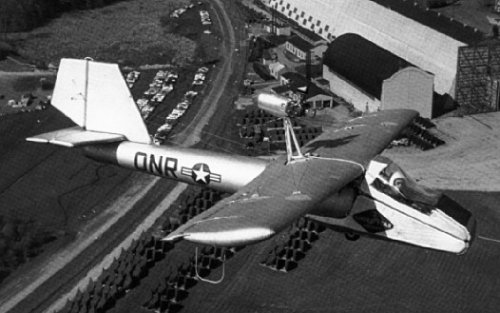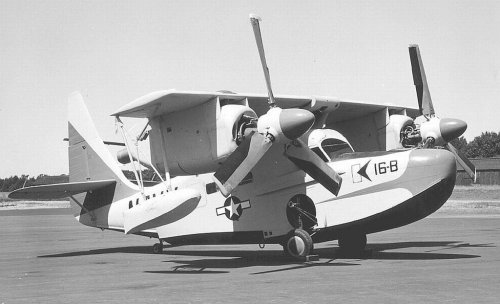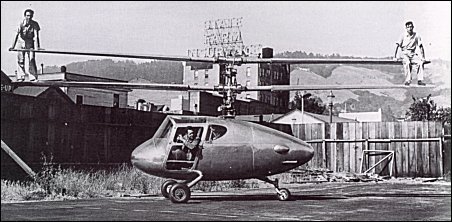Shortly after the end of World War II and its formation, the U.S. Air Force began to use sequential number X designations for experimental aircraft. At some point, probably after the war as well, the Navy codified a designation system for purely experimental aircraft that utilized their manufacturer's letter designations. As stated in Model Designation of Naval Aircraft dated 17 May 1961 provided by Andreas Parsch: Airplanes designed and constructed for research purposes are designated by the designer's code number...followed by his design project number, for example: "D-652" would designate a naval research aircraft designed by Douglas and would be the 652nd. design project by Douglas.
Although it may not be significant, note that this definition refers to design numbers, not model numbers, which are different lists in some companies like Bell Aircraft.
These Model Designation lists were periodically issued by BuAer and successor organizations. Thanks to Ryan Crierie and Andreas, I was able to review the April 1945 and October 1947 lists. Neither include the definition above. The only experimental aircraft listed is the D-558 in the October 1947 issue.
The experimental Navy aircraft that I am familiar with are:
Vought V-173: As has been pointed out, this is Vought's internal designation: if it had been designated in accordance with the 1961 definition, it would have been U-173. Although begun with Vought money, it was subsequently assigned a BuNo in the early 1940s and was marked and referred to as the V-173 by the Navy. I agree that it probably predates the convention later adopted.
Douglas D-558: This was a Navy three-phase high speed research program contracted with Douglas in June 1945. It may or may not predate the convention. The first three airplanes were designated D-558-1 and the second three D-558-2, although it is likely that Douglas assigned a different model number to the -2 Skyrockets. The designation D-558-3 is completely bogus. The third phase of the original program was simply to be a mockup of an operational jet fighter and the Douglas proposal for what some refer to as the -3 never uses this designation. As Douglas well knew, they were competing for a rocket ship that would be designated X-15.
Bell L-39: Even though a research designation convention is not included in the 1947 Model Designation list (and neither is the L-39 or Bell as a fixed-wing airplane manufacturer), this is evidence that the convention might have been used as early as 1946 when BuAer contracted for two L-39s, a modification of the P-63 to have swept wings. L was the letter assigned by the Navy for Bell aircraft. According to Birch Matthews in his book Cobra!, 39 was Bell's design number for the project. (Bell design numbers were assigned by engineering while model numbers were assigned by management.) In any event, one of the Bell reports on the testing begins with the model number 33, which is the basic model number for the first P-63s. The Navy evaluated the L-39s for a few months in 1946 and then one was taken over by NACA and the other by Bell, so it's not surprising that they did not appear in the 1947 list.
Kaman K-225: The Navy bought three of the primitive Kaman intermeshing rotor (synchropter) model 225s for evaluation in 1950, assigned them BuNos, and gave them the designation K-225. Again, this is not conclusive evidence that the convention was being used at the time, per se, because it was the company's internal designation. One of the Navy's K-225s was subsequently modified with a turbine engine replacing the Lycoming 225-hp (the basis for the Kaman model number) piston engine.
Convair Y2-2: This is the cleanest example of the convention being used, whether it had been formally established at the time or not. Y was the Navy's letter for Convair and 2-2 was the company model designation. Convair received a contract for two as research airplanes in January 1951 but these were redesignated XF2Y-1 later that year.
Kaman K-16: The Navy contracted with Kaman for a tiltwing STOL ground test article (half of the wing, one engine, nacelle, and prop) as the K-16 in February 1956. In January 1958, this contract was amended to add the design and manufacture of the K-16B, which consisted of the K-16 wing and a Grumman JRF fuselage. It never flew but was tested in the NASA Ames 40X80 wind tunnel in late 1962. A K-16C proposal with a Kaman HU2K fuselage and fixed wing aircraft empennage did not result in a contract.
Goodyear GA-468: This inflatoplane was evaluated at NATC circa 1959/1960. I don't know if it ever got a BuNo or a Navy designation. The Army/Air Force designation was apparently AO-3.
Although it may not be significant, note that this definition refers to design numbers, not model numbers, which are different lists in some companies like Bell Aircraft.
These Model Designation lists were periodically issued by BuAer and successor organizations. Thanks to Ryan Crierie and Andreas, I was able to review the April 1945 and October 1947 lists. Neither include the definition above. The only experimental aircraft listed is the D-558 in the October 1947 issue.
The experimental Navy aircraft that I am familiar with are:
Vought V-173: As has been pointed out, this is Vought's internal designation: if it had been designated in accordance with the 1961 definition, it would have been U-173. Although begun with Vought money, it was subsequently assigned a BuNo in the early 1940s and was marked and referred to as the V-173 by the Navy. I agree that it probably predates the convention later adopted.
Douglas D-558: This was a Navy three-phase high speed research program contracted with Douglas in June 1945. It may or may not predate the convention. The first three airplanes were designated D-558-1 and the second three D-558-2, although it is likely that Douglas assigned a different model number to the -2 Skyrockets. The designation D-558-3 is completely bogus. The third phase of the original program was simply to be a mockup of an operational jet fighter and the Douglas proposal for what some refer to as the -3 never uses this designation. As Douglas well knew, they were competing for a rocket ship that would be designated X-15.
Bell L-39: Even though a research designation convention is not included in the 1947 Model Designation list (and neither is the L-39 or Bell as a fixed-wing airplane manufacturer), this is evidence that the convention might have been used as early as 1946 when BuAer contracted for two L-39s, a modification of the P-63 to have swept wings. L was the letter assigned by the Navy for Bell aircraft. According to Birch Matthews in his book Cobra!, 39 was Bell's design number for the project. (Bell design numbers were assigned by engineering while model numbers were assigned by management.) In any event, one of the Bell reports on the testing begins with the model number 33, which is the basic model number for the first P-63s. The Navy evaluated the L-39s for a few months in 1946 and then one was taken over by NACA and the other by Bell, so it's not surprising that they did not appear in the 1947 list.
Kaman K-225: The Navy bought three of the primitive Kaman intermeshing rotor (synchropter) model 225s for evaluation in 1950, assigned them BuNos, and gave them the designation K-225. Again, this is not conclusive evidence that the convention was being used at the time, per se, because it was the company's internal designation. One of the Navy's K-225s was subsequently modified with a turbine engine replacing the Lycoming 225-hp (the basis for the Kaman model number) piston engine.
Convair Y2-2: This is the cleanest example of the convention being used, whether it had been formally established at the time or not. Y was the Navy's letter for Convair and 2-2 was the company model designation. Convair received a contract for two as research airplanes in January 1951 but these were redesignated XF2Y-1 later that year.
Kaman K-16: The Navy contracted with Kaman for a tiltwing STOL ground test article (half of the wing, one engine, nacelle, and prop) as the K-16 in February 1956. In January 1958, this contract was amended to add the design and manufacture of the K-16B, which consisted of the K-16 wing and a Grumman JRF fuselage. It never flew but was tested in the NASA Ames 40X80 wind tunnel in late 1962. A K-16C proposal with a Kaman HU2K fuselage and fixed wing aircraft empennage did not result in a contract.
Goodyear GA-468: This inflatoplane was evaluated at NATC circa 1959/1960. I don't know if it ever got a BuNo or a Navy designation. The Army/Air Force designation was apparently AO-3.




